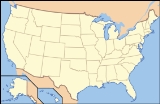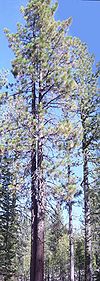
Boulder Creek Wilderness
Encyclopedia
The Boulder Creek Wilderness is a wilderness area located in the Umpqua National Forest
in the southern Cascade Range
of Oregon
, United States
. It was designated by the United States Congress
in 1984 and comprises 19100 acres (7,730 ha).
There is more than 30 miles (48.3 km) of hiking trails in the Wilderness, including the 10.6 miles (17.1 km) mile Boulder Creek Trail and the 3.5 miles (5.6 km) Jessie Wright segment of the North Umpqua Trail.
.
 1420 acres (5.7 km²) of the Boulder Creek Wilderness is designated the Umpqua Rocks Special Interest Geologic Area. Large volcanic basalt
1420 acres (5.7 km²) of the Boulder Creek Wilderness is designated the Umpqua Rocks Special Interest Geologic Area. Large volcanic basalt
and andesite
monolithic spires with names such as Eagle Rock, Rattlesnake Rock, and Old Man are prominent landscape features. These spires are popular among rock climbers.
The geologic formations in this area date to the early Tertiary Period, some 30 million years ago. Volcanic intrusions, stocks, plugs and dikes were more common during this period of time. Later periods involved pyroclastic tuff
s and breccia
s associated more with volcanic flows of andesite and dacite
material.
Umpqua National Forest
Umpqua National Forest, in southern Oregon's Cascade mountains, covers an area of one-million acres in Douglas, Lane, and Jackson Counties, and borders Crater Lake National Park. The four ranger districts that comprise the Forest are Cottage Grove, Diamond Lake, North Umpqua, and Tiller Ranger...
in the southern Cascade Range
Cascade Range
The Cascade Range is a major mountain range of western North America, extending from southern British Columbia through Washington and Oregon to Northern California. It includes both non-volcanic mountains, such as the North Cascades, and the notable volcanoes known as the High Cascades...
of Oregon
Oregon
Oregon is a state in the Pacific Northwest region of the United States. It is located on the Pacific coast, with Washington to the north, California to the south, Nevada on the southeast and Idaho to the east. The Columbia and Snake rivers delineate much of Oregon's northern and eastern...
, United States
United States
The United States of America is a federal constitutional republic comprising fifty states and a federal district...
. It was designated by the United States Congress
United States Congress
The United States Congress is the bicameral legislature of the federal government of the United States, consisting of the Senate and the House of Representatives. The Congress meets in the United States Capitol in Washington, D.C....
in 1984 and comprises 19100 acres (7,730 ha).
There is more than 30 miles (48.3 km) of hiking trails in the Wilderness, including the 10.6 miles (17.1 km) mile Boulder Creek Trail and the 3.5 miles (5.6 km) Jessie Wright segment of the North Umpqua Trail.
Topography
Boulder Creek Wilderness ranges in elevation from 1600 to 5600 ft (487.7 to 1,706.9 m). It surrounds Boulder Creek and its tributaries, which flows south and west through the heart of the Wilderness and drains into the Wild and Scenic North Umpqua RiverNorth Umpqua River
The North Umpqua River is a tributary of the Umpqua River, approximately long, in southwestern Oregon in the United States. It drains a scenic and rugged area of the Cascade Range southwest of Eugene, flowing through steep canyons and surrounded by large Douglas-fir forests...
.
Geology

Basalt
Basalt is a common extrusive volcanic rock. It is usually grey to black and fine-grained due to rapid cooling of lava at the surface of a planet. It may be porphyritic containing larger crystals in a fine matrix, or vesicular, or frothy scoria. Unweathered basalt is black or grey...
and andesite
Andesite
Andesite is an extrusive igneous, volcanic rock, of intermediate composition, with aphanitic to porphyritic texture. In a general sense, it is the intermediate type between basalt and dacite. The mineral assemblage is typically dominated by plagioclase plus pyroxene and/or hornblende. Magnetite,...
monolithic spires with names such as Eagle Rock, Rattlesnake Rock, and Old Man are prominent landscape features. These spires are popular among rock climbers.
The geologic formations in this area date to the early Tertiary Period, some 30 million years ago. Volcanic intrusions, stocks, plugs and dikes were more common during this period of time. Later periods involved pyroclastic tuff
Tuff
Tuff is a type of rock consisting of consolidated volcanic ash ejected from vents during a volcanic eruption. Tuff is sometimes called tufa, particularly when used as construction material, although tufa also refers to a quite different rock. Rock that contains greater than 50% tuff is considered...
s and breccia
Breccia
Breccia is a rock composed of broken fragments of minerals or rock cemented together by a fine-grained matrix, that can be either similar to or different from the composition of the fragments....
s associated more with volcanic flows of andesite and dacite
Dacite
Dacite is an igneous, volcanic rock. It has an aphanitic to porphyritic texture and is intermediate in composition between andesite and rhyolite. The relative proportions of feldspars and quartz in dacite, and in many other volcanic rocks, are illustrated in the QAPF diagram...
material.
Vegetation
Old growth Ponderosa pines flourish on Pine Bench, near the lower end of Boulder Creek Wilderness. This is thought to be the largest such stand this far northwest of the crest of the Cascade Mountains. In 1996, the 16500 acres (6,677.3 ha) Spring Fire burned through much of the Wilderness. Scientists have since been in the area studying the long-term ecological effects of the fire.See also
- List of Oregon Wildernesses
- List of U.S. Wilderness Areas
- List of old growth forests
- Wilderness ActWilderness ActThe Wilderness Act of 1964 was written by Howard Zahniser of The Wilderness Society. It created the legal definition of wilderness in the United States, and protected some 9 million acres of federal land. The result of a long effort to protect federal wilderness, the Wilderness Act was signed...
External links
- Boulder Creek Wilderness - Umpqua National Forest

